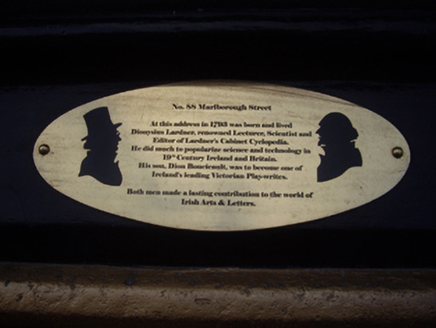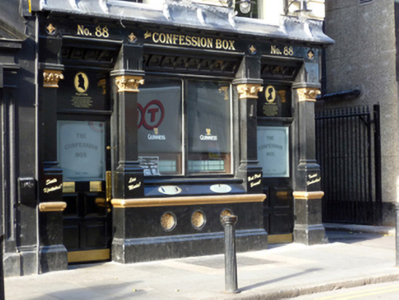Survey Data
Reg No
50010241
Rating
Regional
Categories of Special Interest
Architectural, Artistic, Historical, Social
Previous Name
The Maid of Erin
Original Use
House
In Use As
Public house
Date
1880 - 1900
Coordinates
316023, 234733
Date Recorded
27/10/2011
Date Updated
--/--/--
Description
End-of-terrace two-bay four-storey house, built c.1800, with cellar, now in use as public house and having pub-front of c.1890 to ground floor. Slated hipped roof and brick chimneystack hidden behind parapet with painted masonry coping to both elevations. Ruled-and-lined rendered walls having blocked quoins and moulded string courses forming sills to second and third floors and running into pediments to first floor windows. Moulded stucco roundel with street number between first floor windows. Flat-arched window openings having moulded stucco architraves and pediments of various profiles enclosing painted timber single-pane sliding sashes throughout. Ornate Victorian shopfront proud of building line with decorative lead dressing above. Fascia with gilded sign-writing. Paired engaged pilasters with gilded foliate capitals flanking doors to either side of display window with central mullion on dwarf wall with three decorative brass grilles under sloping sill. Painted timber doors with etched glass panels above.
Appraisal
This well-presented licensed premises, with its elaborate late Victorian pub-front, is an excellent example of its type, with the recent decorative leadwork above the coved fascia maintaining this high-quality standard. Dionysius Lardner (1793-1859), editor of "Cabinet Cyclopedia", a popularizer of science in Ireland, was born and lived at a house at this address in the late eighteenth century. He was the father of the playwright, Dion Boucicault (1820-90), who was most well known for his perennially popular play "The Colleen Bawn". During the War of Independence (1919-21), sympathetic priests used this pub, then known as "The Maid of Erin", as a venue to hear the confessions of the rebel fighters who had been ex-communicated by the church hierarchy. This gave rise to the new name for a building steeped in social history: "The Confession Box".













